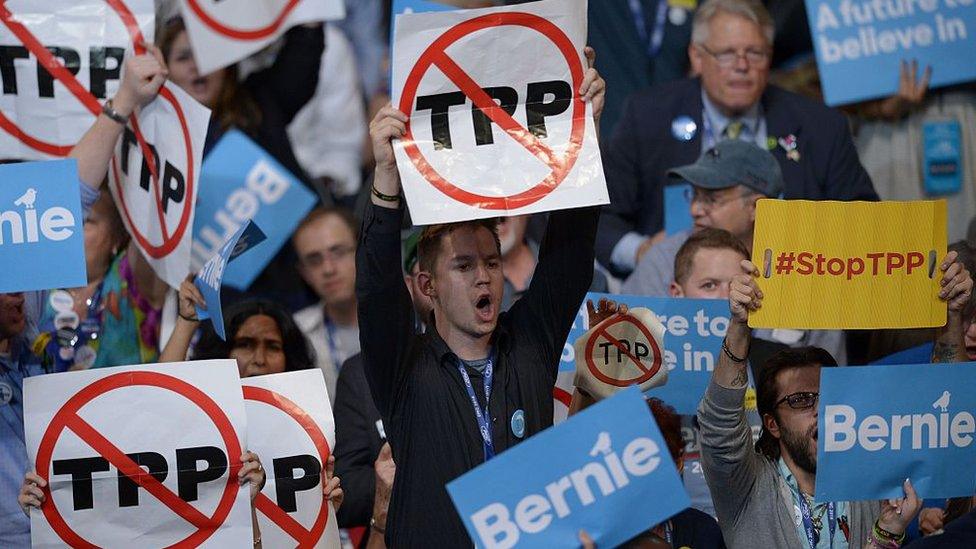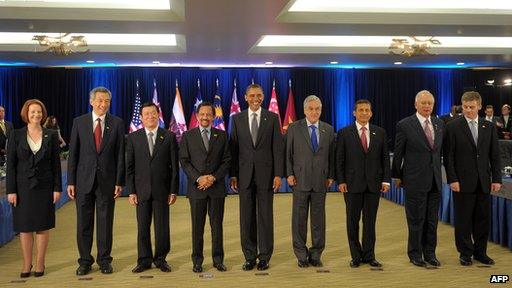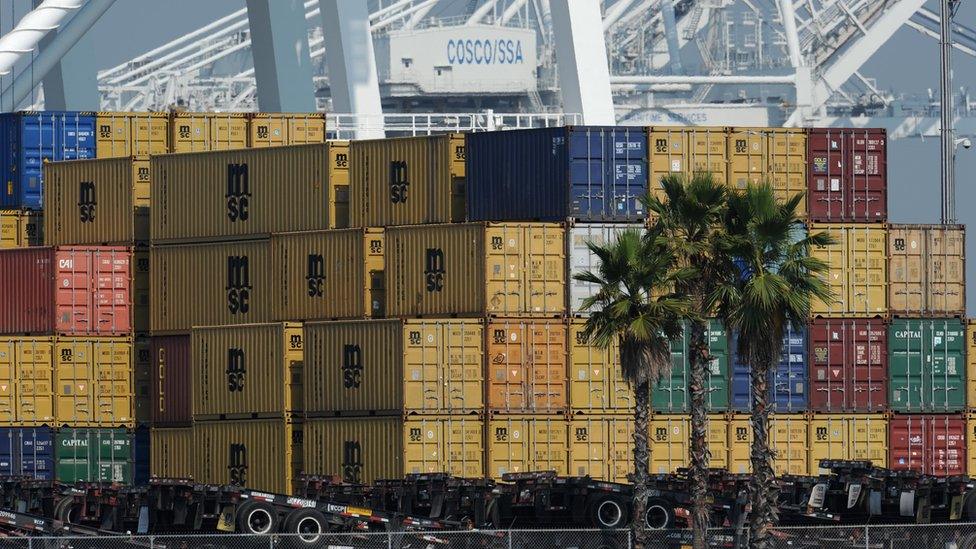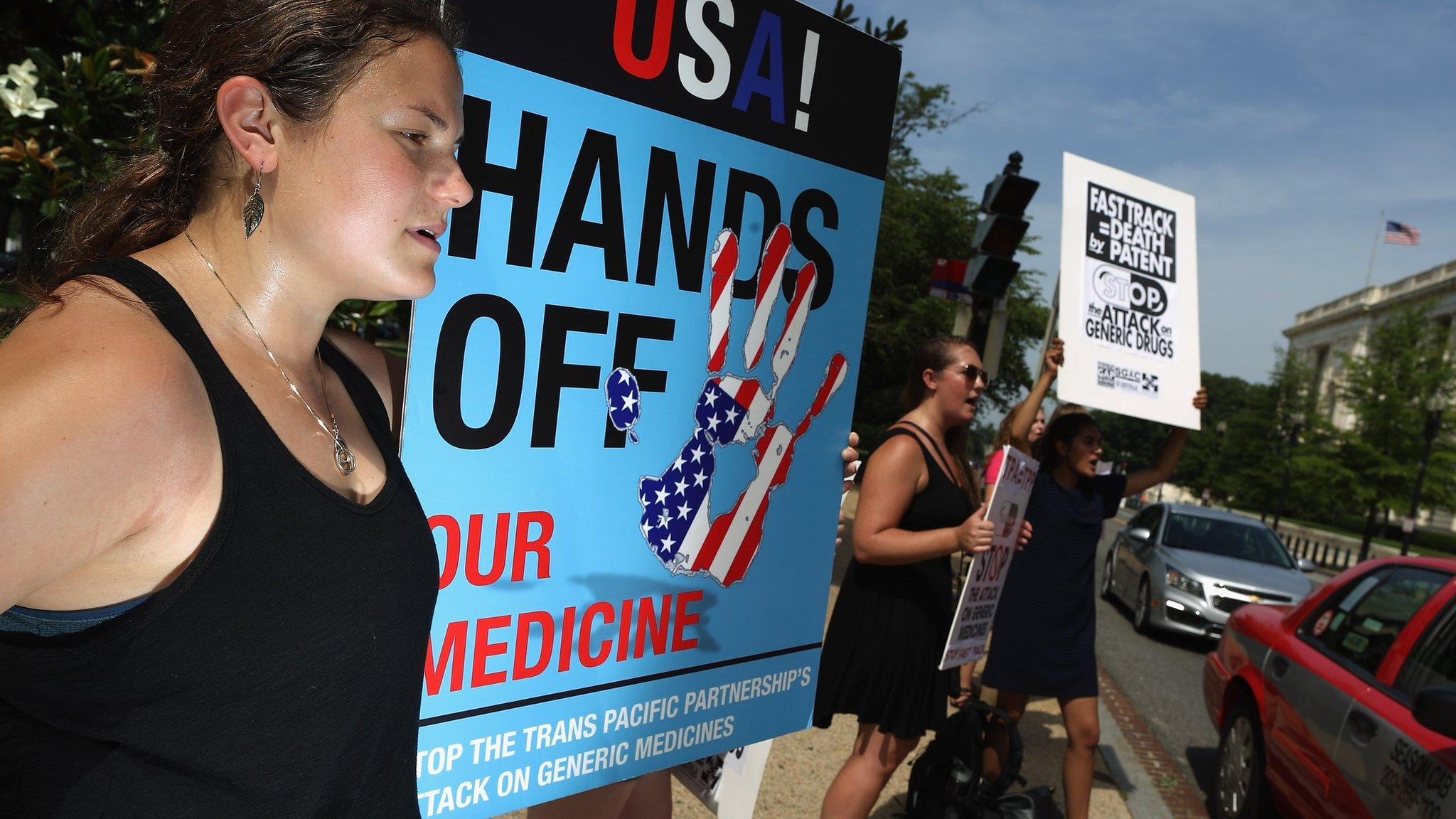TPP: What is it and why does it matter?
- Published

Governments and large corporations may have hammered out agreements to craft a TPP that suits them - but some see no gain for workers
US President Donald Trump made abandoning the Trans-Pacific Partnership (TPP) trade deal a key part of his election campaign and on his first day in office, he has proved as good as his word.
But what was the TPP designed to do? And does it have any future without the US?
TPP in a nutshell
Twelve countries that border the Pacific Ocean signed up to the TPP in February 2016, representing roughly 40% of the world's economic output.
The pact aimed to deepen economic ties between these nations, slashing tariffs and fostering trade to boost growth. Members had also hoped to foster a closer relationship on economic policies and regulation.
The agreement was designed so that it could eventually create a new single market, something like that of the EU.
But all 12 nations needed to ratify it, before it could come into effect.
Once Donald Trump won last year's election, the writing was on the wall for the TPP.
US participation was the major linchpin for the deal. It may be possible for the other countries to forge a smaller scale pact in its place, but it can't go ahead in its current form.
Those other member states are: Japan - the only country to have already ratified the pact - Malaysia, Vietnam, Singapore, Brunei, Australia, New Zealand, Canada, Mexico, Chile and Peru.
For and against
Former President Barack Obama treated trade deals as a priority during his tenure, and this particular deal would have bolstered America's position in the Asia-Pacific region, where China is growing in influence.
But US opponents have characterised the TPP as a secretive deal that favoured big business and other countries at the expense of American jobs and national sovereignty.
On the campaign trail Donald Trump called it a "horrible deal".

It wasn't just Trump who opposed the deal
But it's not just Mr Trump who opposed the deal. Critics on the left also said it had cost US jobs and said the TPP would pave the way for companies to sue governments that change policy on, say, health and education to favour state-provided services. And it was also seen as intensifying competition between countries' labour forces.
How big a deal was the TPP?
Pretty big. The 12 countries involved have a collective population of about 800 million - almost double that of the European Union's single market. The 12-nation would-be bloc is already responsible for 40% of world trade.
The deal was seen as a remarkable achievement given the very different approaches and standards within the member countries, including environmental protection, workers' rights and regulatory coherence - not to mention the special protections that some countries have for certain industries.
The US pulling out will be seen as big blow for other nations that signed up.

US President Barack Obama spent much of his presidency working towards a deal on TPP
Without the US does it definitely fail?
To take effect, the deal would have had to be ratified by February 2018 by at least six countries that account for 85% of the group's economic output. The US would need to be on board to meet that last condition.
Some countries, including New Zealand, have suggested some sort of alternative deal may be possible without the US.
But Japan's Prime Minister Shinzo Abe has said a TPP without the US - and its market of 250 million consumers - would be "meaningless".
Is this the same thing as TTIP?
Confusingly not.
The Transatlantic Trade and Investment Partnership, now generally known as TTIP, is a deal to cut tariffs and regulatory barriers to trade between the US and member states of the EU. Negotiations here are at an earlier stage. But given President Trump's hostility towards trade deals in general it's unlikely to be plain sailing for that one either.
Which goods and services are involved in the TPP?
Most goods and services traded between the countries are named in the TPP, but not all tariffs - which are taxes on imports - were going to be removed and some would take longer than others. In all, some 18,000 tariffs were included.
For example, the signatories said they would either eliminate or reduce tariffs and other restrictive policies from agricultural products and industrial goods.
Under the agreement, tariffs on US manufactured goods and almost all US farm products would have gone almost immediately. But some "sensitive" products would have been exempt until a later agreed date.
The full text of the TPP agreement - which runs to 30 chapters - can be read here, external.
And you can find more on the specific industries involved here.
When did it start?
It began with the P4 trade agreement, external between just four nations - Brunei, Chile, New Zealand and Singapore - that came into effect in 2006.
That deal removed tariffs on most goods traded between the countries, promised to cut more and also to co-operate on wider issues such as employment practices, intellectual property and competition policies.
Signatories who want to forge ahead with the TPP may need to lower their sights back in line with the earlier incarnation.
- Published6 November 2015

- Published6 October 2015

- Published6 October 2015

- Published24 April 2014